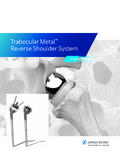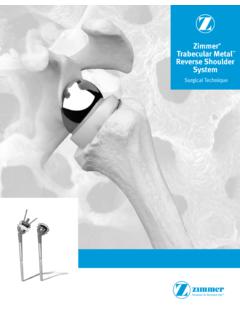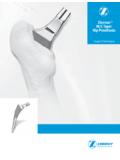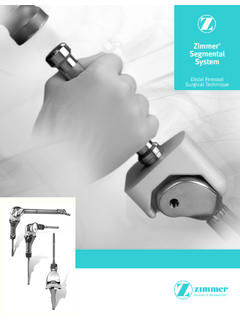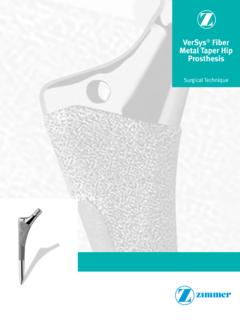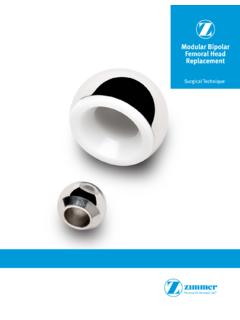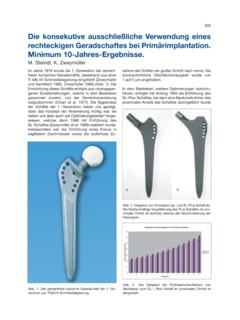Transcription of ALLOCLASSIC HIP SYSTEM - Zimmer Biomet
1 1001-25-031 11/2003 Printed in USA 2003 ZimmerPlease refer to package inserts for complete product information, including contraindications, warnings, precautions, and adverse your Zimmer Representative or visit us at ALLOCLASSIC HIP SYSTEMS urgical TechniqueClassic proven design with superior clinical results. 22 ALLOCLASSICHIP SYSTEMD eveloped in conjunction with:Frank Gottschalk, MDProfessor, Orthopedic SurgeryThe University of TexasSouthwestern Medical Center at DallasDallas, TXD. Kevin Lester, MDAssistant Professor, Orthopedic SurgeryUniversity of California at San FranciscoFresno, FOR THE OF THE FEMORAL OF THE FEMORAL SPECIFICATIONS AND SYSTEM The ALLOCLASSIC stem was introduced to the global market in 1986, after seven years of extensive research and development. Since its introduction, the ALLOCLASSIC has established high standards for total hip arthroplasty with an unchanged design, excellent clinical results, and a technically simple ClassicThe long-term clinical success of the ALLOCLASSIC can be attributed to a unique combination of design features.
2 A tapered stem geometry and a grit-blasted surface provide proven initial and secondary fixation. In addition, the ALLOCLASSIC s rectangular cross-section has unparalleled rotational stability while the broaching technique allows for minimal disturbance to the endosteal blood supply and maximum bone Long-Term Clinical ResultsThe ALLOCLASSIC Hip is regarded by surgeons world-wide as the standard for total hip arthroplasty with over 16 years of excellent clinical results. Broad Product IndicationsThe versatile ALLOCLASSIC can be used in trauma cases, primary hip arthroplasty and revision hip arthroplasty in all bone types, from low- to high-demand ALLOCLASSIC s 12/14 taper is compatible with multiple Zimmer acetabular options, including unipolar and bipolar heads, ceramic heads, Metasul metal-on-metal and Durasul highly crosslinked polyethylene in head diameters up to 44 FixationThe ALLOCLASSIC s grit-blasted titanium niobium alloy with a 4-8 micron surface roughness provides a proven surface for reliable biologic fixation for long-term fixation of the CompatibilityThe ALLOCLASSIC s tapered design and non-reaming technique allow for minimal disturbance to the endosteal bloody supply and maximum bone conservation, and make it the perfect choice for Minimally Invasive Surgery.
3 The ALLOCLASSIC hip has been successfully used in MIS hip arthroplasty for over 16 years. Extensive SizingFourteen anatomical sizes allow for an optimal patient fit. 34 Preoperative PlanningThe primary objectives of preoperative planning are to:1. Determine preoperative leg length Assess acetabular component size and Determine femoral component size, position and Assess the necessary femoral addition, preoperative planning will assist in the identification of bone abnormalities and potential problems before surgery that might require special for X-raysFor the A/P X-ray of the pelvis, the femurs should be internally rotated 15 to show an accurate view of the femoral neck length, metaphysis and diaphysis. A direct lateral X-ray may also be beneficial in determining implant sizing. The ALLOCLASSIC Hip SYSTEM templates incorporate 18 percent the FemurTo estimate the leg length discrepancy on the X-ray a line should be drawn through the bottom of the ischium (Fig.)
4 1). The distance should then be measured from the lesser trochanter to the drawn reference line. The measured difference between each measured side is the radiographic leg length discrepancy. As an alternate reference point, the tip of the greater trochanter to the drawn reference line may be measured. Fig. 156 Fig. 2 Postoperative A/P ViewPostoperative Lateral ViewTemplating the FemurSelect the femoral template size that will best fit the proximal and distal femur and equalize the leg length. The tapered geometry of the ALLOCLASSIC should fill the canal from the medial to the lateral cortical wall (Fig. 2). The femoral template should be in line with the long axis of the femur, in the neutral position. Draw the neck resection line at the point where the selected stem provides the desired amount of leg length. The proximal tip of the prosthesis and the tip of the greater trochanter are suitable reference points for determining the height of the final implant.
5 Preoperative A/P View56 Femoral PreparationOsteotomy of the Femoral NeckThe osteotomy of the femoral neck is 1-2 cm above the lesser trochanter at an angle of 40-45 to the neutral axis of the femur or parallel to the intertrochanteric line. This may vary due to differences in the proximal femoral anatomy and should be based on preoperative planning (Fig. 3-4). The femoral head is then removed (Fig. 5).The leg is then externally rotated to neutral in full extension to provide the best exposure for preparation of the 3 Fig. 4 Fig. 540 78 Preparation of the Femoral CanalAfter the acetabular component has been placed, the leg is then repositioned for optimal access to the femoral canal. With the knee bent at 90 , the leg is internally rotated. The cut surface of the femoral neck is now easily accessible for femoral preparation, for a posterior the antero-lateral approach, the leg is adducted and externally rotated to allow for access to the cut surface of the femoral rectangular box chisel is used to cut a slot in the proximal neck and trochanteric region.
6 The chisel should be as lateral as possible against the transition to the greater trochanter to create a slot to accommodate the prosthesis in a neutral position (Fig. 6-7). Fig. 6 Fig. 7 Part # UsedBox Chisel [ ]78 Preparation of the Femoral CanalThe slot may be extended laterally by notching the cortex of the trochanter using a rongeur or small rasp (Fig. 8 and 9).Next, the canal finder should be used to further open the medullary canal. Caution should be used to ensure that a neutral opening to the canal is established and varus positioning is avoided (Fig. 10).Fig. 8 Fig. 10 CorrectIncorrectFig. 9910 Preparation of the Femoral CanalPrepare the femoral canal by first using rasp size 1, and progress to the next larger size rasp. Only in cases of very small femora should one start with the special sizes 01 and 0. To ensure proper rasp height and subsequent implant height, calibration marks are located on the connector piece, which reference the height of the final implant (Fig.)
7 11).The proximal tip of the ALLOCLASSIC will rest just below the tip of the greater trochanter when the implant is finally shaft of the slaphammer is aligned along the femoral axis, while the impactor handle may be used to reference the anteversion of the rasp and final hip implant (Fig. 12).Fig. 12 Fig. 11 Part # 6835 Instruments UsedAdaptor with Lever [6835]910 Preparation of the Femoral CanalThe insertion of the first rasp will determine the anteversion of the subsequent rasps and the final implant, so precise orientation is necessary for exact stem positioning (Fig. 13). Once again, the lateral trochanter area should be periodically rasped to avoid varus implantation. Each rasp should be impacted to the level of the osteotomy and the angled proximal surface of the first contact with the cortex usually occurs at the distal end of the rasp. Progress will become more difficult with each progressive impaction and the pitch of the impactor will change from low to high once cortical bone is engaged.
8 The next larger size rasp is usually the final size as preoperatively templated. The final rasp should be seated to the resection line and there should be no visible movement of the broach when the slaphammer is final implant size will directly correspond to the final rasp 131112 Trial ReductionTrial reduction of the ALLOCLASSIC may be accomplished with either the rasp or the trial prosthesis. The two methods are slightly different, so they are each described below. The recommended method for trialing the ALLOCLASSIC is with the trial prosthesis because this best replicates the final implant range of motion and stem directly off of the rasp is first accomplished by removing the rasp handle and leaving the rasp in the femoral canal. Either a trial rasp ball head or a trial rasp taper is then inserted into the rasp hole (Fig. 14). If the trial rasp taper is selected, any of the standard 12/14 trial ball heads may then be used in conjunction with a trial rasp taper.
9 A special trial rasp taper is available for the smallest rasps, sizes 01 and 0 (Part #6842).Once the appropriate trial head is selected, the hip is reduced. Leg length and offset are checked. This procedure is repeated as necessary using different length trial heads until optimal offset and leg length are established. A trial reduction should not allow significant push-pull or shuck of the joint in full extension. Range of motion is checked to avoid bony impingement and 14orPart # UsedTapered Bolt [ ]1112 Trial OptionTrialing with the trial prosthesis is first accomplished by removing the final rasp. A trial prosthesis matching the size of last rasp is inserted and driven in with the impactor instrument on the proximal tip of the trial prosthesis (Fig. 15). Once the trial is firmly seated, the trial ball head size as templated is connected to the trial taper (Fig. 16). The hip is then reduced. Next, leg length and offset are checked. This procedure is repeated as necessary using different length trial heads until optimal offset and leg length are established.
10 A trial reduction should not allow significant push-pull or shuck of the joint in full extension. Range of motion is checked to avoid bony impingement and instability. The trial prosthesis is removed with the slaphammer and extractor hook, which is inserted into the proximal tip of the trial prosthesis (Fig. 17).Fig. 15 Fig. 16 Fig. 171314 Stem ImplantationThe stem is inserted and impacted using the impactor in contact with the proximal tip of the prosthesis (Fig. 18). The taper protector is removed from the taper and a trial head may be applied at this time for a final trial head reduction. Once the final range of motion and shuck tests are complete, the taper is carefully cleaned. The selected cobalt chrome or ceramic 12/14 taper femoral head is mounted with a light rotational movement, and rotated further with axial force until it is firmly ball head is seated with several taps with the ball head impactor instrument (Fig. 19).Fig. 18 Fig. 191314 Implant CharacteristicsThe ALLOCLASSIC hip is the most widely used primary cementless hip in the world.
